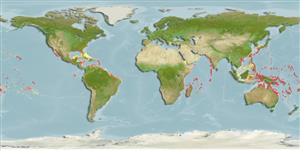Trichoplax adhaerens Schulze, 1883
| Native range | All suitable habitat | Point map | Year 2050 |

|
| This map was computer-generated and has not yet been reviewed. |
| Trichoplax adhaerens AquaMaps Data sources: GBIF OBIS |
Upload your photos
Google image |
No photo available for this species.No drawings available for Trichoplacidae.
Google image |
No photo available for this species.
Classification / Names Common names | Synonyms | CoL | ITIS | WoRMS
| Not assigned | Trichoplacidae
Environment: milieu / climate zone / depth range / distribution range นิเวศวิทยา
. Tropical
การแพร่กระจาย ประเทศต่างๆ | พื้นที่จำแนกตาม FAO | ระบบนิเวศหลายระบบ | การปรากฏขึ้น,การเกิดขึ้น,พบ | การแนะนำ
Circumglobal.
Length at first maturity / ขนาด / น้ำหนัก / Age
Maturity: Lm ? range ? - ? cm
Short description สัณฐานวิทยา
Flat (up to 0.5mm in its longest dimension), multicellular, amorphous, mobile flagellated animal lacking body cavity, digestive and nervous systems, composed of 2 layers of epithelial cells. Associated glandular cells apparently secrete digestive enzymes beneath the animal as it sits atop the algae and protozoans on which it apparently feeds; digestion seems to be entirely extracellular , as there is no mouth and no sign of phagocytosis. The much thinner, upper layer of the animal bears flagellated cells, but no gland cells. In a sense, the upper layer is ectodermal, while the lower layer, because of its involvement in digesting food and absorbing nutrients, is endodermal. Between the upper and lower cell layers is a fluid-filled space containing a dense network of fibrous cells that may be contractile (Ref. 53).
Commonly found in warm marine environments (Ref. 57) and in marine aquaria (Ref. 59), on hard bottom substrates in the benthic regions (Ref. 53). A scavenger which feeds on dead animals with its ventral surface, which produces digestive enzymes (Ref. 53), and also feeds on Cryptomonas (Ref. 57 and 60) and algae (Ref. 59); often, individuals contract part of the ventral surface into a sac where digestion may take place more efficiently (Ref. 60).
Life cycle and mating behavior วัยเจริญพันธุ์ | การสืบพันธุ์ | การวางไข่ | เซลสืบพันธ์ของเพศเมีย(ไข่) | ความดกของไข่ | ตัวอ่อน
Reproduces asexually, binary fission, budding (Ref. 60), fragmentation (Ref. 53). Older cultures at high density begin to produce small motile presumptive sperm cells, and as individual animals disintegrate, they spew out ova (Refs. 59, 61).
Main reference
อ้างอิง | ผู้ประสานงาน | ผู้ร่วมมือ
Collins, A.G. 2000. (Ref. 60)
IUCN Red List Status (Ref. 130435)
CITES status (Ref. 108899)
Not Evaluated
CMS (Ref. 116361)
Not Evaluated
Threat to humans
Harmless
Human uses
| FishSource |
เครื่องมือ
ข้อมูลเพิ่มเติม
ประเทศต่างๆ
พื้นที่จำแนกตาม FAO
ระบบนิเวศหลายระบบ
การปรากฏขึ้น,การเกิดขึ้น,พบ
การแนะนำ
Stocks
นิเวศวิทยา
อาหาร, โภชนาการ
รายการอาหาร
พื้นที่จำแนกตาม FAO
ระบบนิเวศหลายระบบ
การปรากฏขึ้น,การเกิดขึ้น,พบ
การแนะนำ
Stocks
นิเวศวิทยา
อาหาร, โภชนาการ
รายการอาหาร
ชื่อสามัญ
ชื่อพ้อง
ผู้ล่า
การสืบพันธุ์
วัยเจริญพันธุ์
การวางไข่
ความดกของไข่
เซลสืบพันธ์ของเพศเมีย(ไข่)
Egg development
ชื่อพ้อง
ผู้ล่า
การสืบพันธุ์
วัยเจริญพันธุ์
การวางไข่
ความดกของไข่
เซลสืบพันธ์ของเพศเมีย(ไข่)
Egg development
แหล่งที่มาจากอินเตอร์เน็ต
BHL | BOLD Systems | CISTI | DiscoverLife | FAO(Publication : search) | Fishipedia | GenBank (genome, nucleotide) | GloBI | Gomexsi | Google Books | Google Scholar | Google | PubMed | แผนภูมิชีวิตแบบต้นไม้ | Wikipedia (Go, ค้นหา) | บันทึกทางด้านสัตววิทยา
Estimates based on models
Price category
(Ref. 80766):
Unknown.


